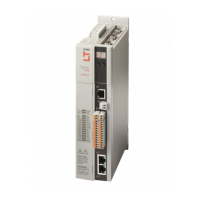NOTE
l Ifasubsequentmotionblockandanalternativemotionblockare
entered,thebranchalwaysleadstothemotionblockforwhichthe
conditionismetfirst.
Switching condition
There are two different modes to choose from for the transition switching to the next
motion block.
ID Index Name Unit Description
2867 HYD_TabCondType
2867 0..15 HYD_TabCondType Hydraulictablestate
Table 7.78: Parameter “Hydraulic table state”
Optional comparison value
Comparison value for the transition switching condition (ConAddr)
ID Index Name Unit Description
2868 HYD_TabCondVal
2868 0..15 HYD_TabCondVal Hydraulictablecomparisonstate
Table 7.79: Parameter “Hydraulic table comparison state”
7.11.7Pressurecontrol
The pressure is controlled by a PI pressure controller using P 2850 - HYD_PressCon
based on the pressure setpoint. Here you can choose between two controller
structures using P 2840 [16] AltPressCon. The selection PressCon_nPump(0)
outputs a pump speed at the output of the controller which is directly forwarded to
the speed controller (see Image 7.67: Mask of pressure control with pump speed
ID No.: 0842.26B.5-01Date: 09.2020
ServoOne- Device Help
198
7 Control
output). The selection PressCon_VolFlow(2) has a volumetric flow rate output in
l/min and an underlying volume flow control which takes the displacement volume of
the pump into account (see Image 7.68: Mask of pressure control with volumetric
flow rate output.). This can be helpful for pumps with a variable displacement
volume, as this means the control circuit gain remains unchanged and the controller
parameters do not need to be adjusted. If during operation of the pressure control
one of the specified limit values P 2850 [7] - Qmin or P 2850 [8] - Qmax is reached
due to the pump speed, the actuating variable (motor speed) is limited accordingly.
Moreover, the configured speed limits (P 2851.5 nMin, P2851.6 nMax) for the pump
always take priority. In addition, it is possible to set the minimum and maximum
system pressure via a pressure limitation. To take into account the different area
ratio of a differential cylinder, the actual pressure values can be scaled to the
respective area ratio using UnitScale_pAct and UnitScale_pAct2 (P 2850.12
pActScale, P 2850.13 pAct2Scale).
For control systems with high dynamic performance, it may be necessary to take into
account a pressure-dependent compressibility in the control system. This
compressibility will decrease as the pressure increases, i.e. less fluid needs to be
pumped for the same pressure change. Accordingly, the pressure controller’s gain
needs to be reduced at higher pressures in order to maintain a constant pressure
control circuit dynamic performance. Because of this, pressure-dependent controller
gain scaling has also been incorporated. This scaling can be configured with a
characteristic curve (P2853 - HYD_PressConScale).
The pressure controller settings were duplicated in P 2874 HYD_PressCon2. With
this it is possible to select a different controller setting for a selected table motion
block. The second controller data set can be selected in the table motion block using
P 2863 HYD_TabCtr bit 12.
In order to provide feedback to a higher-order control system, a setpoint window for
“Pressure reached” (Para 2850.9 - PressWindow) can be specified. If the actual
value is within this window, the bit “InWindow” (bit 13) is set in the status word (
see
also section "Hydraulic Motion profile" on page192
). Furthermore, a second

